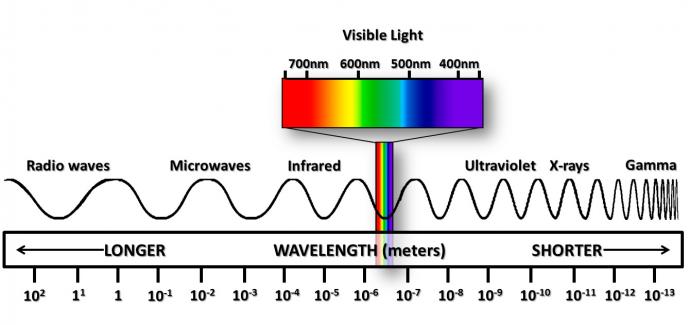http://chriskresser.com/

Microwaves. These handy gadgets have been the source of much debate in the online health community, and it’s not hard to see why. The idea of “zapping,” “nuking,” or otherwise heating your food using microwave radiation can seem a little dubious.
In this article, I’ll take a look at the evidence behind some of the most common microwave concerns. Do microwaves leak radiation? Do microwaves destroy the nutrients in food? Do they denature proteins and make food toxic to our bodies? First, though, let’s start with the basics. How do they work?
How do microwave ovens work?
The aptly-named microwave oven uses microwave radiation to heat food. Electromagnetic (EM) radiation exists over a range of wavelengths, where shorter wavelengths (such as x-rays and gamma rays) have higher energy than longer wavelengths (such as radio waves). On the EM spectrum (pictured below), microwaves fall between radio and infrared waves.
Each level of radiation has different effects on the molecules they interact with. Microwaves contain enough energy to induce molecular rotation, which is the lowest energy form of interaction, but they don’t have enough energy to induce molecular vibrations, electron excitation, or ionization. Microwaves have the greatest effect on water molecules, due to their polar structure, and these rapidly rotating water molecules transfer energy as heat to the other molecules in food.
Do microwaves leak radiation?
One concern many people have about microwave ovens is the simple fact that they emit, well, microwaves. Hasn’t exposure to microwave radiation been linked to cancer and infertility? Evidence is mixed; most published research concludes that low-level microwave exposure doesn’t present a significant risk to human health. (1, 2, 3) Even if it did, this is only an issue if the microwaves inside the microwave somehow escape the microwave and encounter your body, which (as you’ll see below) is unlikely.
The FDA requires that microwaves emit no more than 5 mW/cm2 of radiation at a distance of 2 inches from the microwave. They also point out that microwave radiation dissipates rapidly as you move away from the source, so a measurement taken 20 inches from the microwave would be about 1/100 of the measurement taken at 2 inches. This is good news, because it means that to avoid radiation from your microwave, all you have to do is step away from it while your food is heating.
Are #microwaves as unhealthy as we are told?
The other good news is that in general, real microwave emissions seem to stay below the federally mandated maximum. A study published in 2013 on microwaves in Palestine found that the radiation leakage measured one meter from the microwave varied from 0.43 to 16.4 μW/cm2, with an average of 3.64 μW/cm2. (4) A 2001 survey of microwaves in Saudi Arabia concluded that with 95% probability, a microwave will be found to leak between 0.01 and 2.44 mW/cm2 at a distance of 5cm, and only one out of 106 microwaves surveyed was found to leak more than the FDA limit. (5)
For comparison’s sake, a 2013 study measured microwave radiation emitted by cell phones at a distance of 3.5cm from the phone, and found levels of 10 – 40 μW/cm2 during a call and 0.35 – 10.5 μW/cm2 on silent. (6) Based on these numbers, having a cell phone in your pocket on silent mode exposes you to roughly the same level of microwave radiation as standing one meter from your microwave while it’s heating food.
Honestly, just don’t press your face up against the door of the microwave while your food is cooking, and step a few feet away if you can. If you’re going to be concerned about exposure to microwave radiation, you’d probably be better off getting rid of your cellphone than your microwave oven. (But that’s a topic for a another day.)
Do microwaves make proteins toxic?
Now, let’s talk about the effect of microwave heating on food. One oft-cited claim is that microwaves can “denature” proteins, making them toxic to the human body. First of all, I think there are some misconceptions about what exactly “denaturation” is. Contrary to how the word is often used, it doesn’t mean that a protein has ‘changed’ in some unspecified way to make it more toxic. When a protein is “denatured,” that specifically means it has unfolded and lost its three-dimensional shape, but all of the amino acids in the protein are still bonded together.
Heat in general denatures proteins, so cooking your food (using any heating method) will denature the proteins. Cooking can even be defined as heating something enough to denature the proteins. (7) Changes in pH also denature proteins. In fact, guess what one of the functions of stomach acid is? Denaturing the proteins you ingest! Proteins need to be unfolded (denatured) before digestive enzymes can cleave them into individual amino acids to be absorbed in your small intestine. “Denatured proteins” don’t sound so scary any more, do they?
Perhaps what people have in mind when they refer to “protein denaturation” is actually isomerization of amino acids. This is a completely different process, but it is a change that actually affects the nutritive value of proteins. Without getting too into the chemistry, amino acids can exist in two configurations, termed D- and L-, and isomerization is the process by which an amino acid switches from one configuration to the other. Our bodies almost exclusively use the L- form of amino acids, but pH changes and heat can cause amino acids in food to isomerize to the D- forms, which can’t be efficiently digested or utilized by our body. (8)
A few studies where large amounts of isolated D- amino acids are fed to rodents show potential harmful effects, but there’s no evidence that the levels of D- amino acids normally found in food are harmful. (9) Plus, many foods (such as raw dairy from ruminants and some fruits and vegetables) naturally contain low levels of D- amino acids.
In any case, there doesn’t appear to be a significant difference in levels of D- amino acids in foods cooked in the microwave compared with foods heated conventionally. One study conducted in 1989 found higher levels of D- amino acids in microwaved formula compared with other heating methods (10), but several more recent studies have found no difference. (11, 12, 13, 14, 15) Additionally, the general consensus seems to be that if more D- amino acids are formed, it is due primarily to over heating or uneven temperature distribution, rather than a specific effect of microwaves themselves.
Do microwaves destroy nutrients?
As far as vitamins, minerals, antioxidants, and plant phenols, retention does not appear to depend on cooking method. Levels of nutrient retention were sometimes higher in microwaved food, and sometimes lower, depending on time, temperature, and amount of water used in the cooking process. (16, 17, 18, 19, 20)
In general, nutrients are lost from food during any type of cooking, and more nutrients are lost when the temperature is higher or the food is cooked for longer. Water soluble vitamins are readily leached into cooking liquid (no surprise there), so boiling food tends to result in greater nutrient losses than microwaving it with a small amount of water (unless you drink the water you boiled the food in, in which case you’d still be getting most of the nutrients).
As a final interesting data point, one study published in 1995 used a rat model to look at the overall effects of a microwaved diet in vivo. The diet consisted of meat, potatoes, vegetables, and some oil, cooked either in the microwave or conventionally, and was fed to rats for 13 weeks. To magnify any adverse effects of microwave cooking, the study authors added two additional experimental groups that received “abused” food, which had been reheated and cooled a couple times either conventionally or in the microwave. (21) At the end of 13 weeks, they found no adverse effects of microwave cooking on the rats.
Don’t fear the microwave!
In conclusion, microwaves aren’t as scary as some people make them out to be. Yes, they’re another source of microwave radiation in your home, but the levels are extremely low, and can be almost entirely avoided by simply stepping away while your food is heating. And compared with microwave radiation from other devices (particularly cell phones), radiation from your microwave oven is negligible.
Additionally, there’s no evidence that microwaves adversely affect the nutrient profile of foods. Because microwaves are a relatively new device, I prefer to think of them as “guilty until proven innocent” rather than the other way around, but given what we know about EM radiation and its effects on food molecules, there isn’t really a mechanism by which microwaves could destroy nutrients other than heat. And heat, of course, is an issue regardless of cooking method!
If you’re still skeptical of microwaves after reading this, by all means – use whatever cooking method makes you comfortable. I might be one of the few freaks in the world now that still doesn’t use a microwave, but I can’t say that it’s because of any safety concern or scientific concern. I’ve just never liked what they do to the texture of certain foods, and for whatever reason, I’ve never gotten into using one.
But if you enjoy the convenience of a microwave, don’t be afraid to use it – especially if being able to microwave your food makes the difference between heating up leftover Paleo chili or grabbing a Nutri-Grain bar for lunch!
What do you think about microwaves? Did reading this article change your opinion of them? Let me know in the comments!
Filed under: Fitness


 For now classes are 6pm and 640pm at 2840 Wildwood st in the Boise Cloggers studio.
Book your class NOW!
click this ==>
For now classes are 6pm and 640pm at 2840 Wildwood st in the Boise Cloggers studio.
Book your class NOW!
click this ==>








